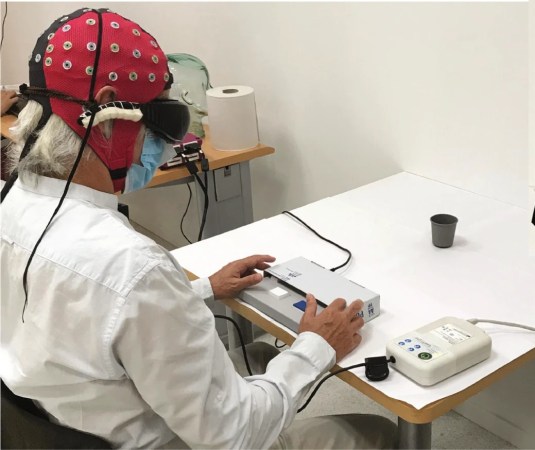

Jill Neimark is a writer based in Atlanta, Georgia, whose work has been featured in Discover, Scientific American, Science, Nautilus, Aeon, NPR, Quartz, Psychology Today, and The New York Times. Her latest book is The Hugging Tree (Magination Press).
This article was originally published on Undark.
On the morning of June 19, 2020—Juneteenth, now a federal holiday—students in the Internal Medicine Residency Program at the University of California, Davis gathered for weekly rounds. Rachael Lucatorto, the associate program director, opened the session by playing a recording of the Emancipation Proclamation. She then jumpstarted a discussion about racism in medicine.
For Bisrat Woldemichael, then a fourth year medical student at UC Davis and now a resident at Emory University, it was a chance to speak about racism in kidney care, or nephrology. Black Americans experience kidney failure nearly four times as often as white Americans. And yet they are less likely to receive timely referrals to a specialist.
One big problem, Woldemichael remembers pointing out that June morning, was that a common tool for measuring kidney health factored in race. “Racism is very obviously present in a lot of ‘objective’ data in medicine,” she says. Many equations and guidelines adjust for race, and while it is sometimes a convenient proxy, critics say doing so reinforces stereotypes and that alternatives could yield more precise results. For kidney health, the practice could lead to great harm, she says, including death.
Most people have two kidneys—bean-shaped organs about the size of a fist—which, among other things, clean the blood, balance electrolytes, and help form red blood cells. To estimate kidney function, doctors use a standard equation called the eGFR, or estimated glomerular filtration rate. The equation uses the kidneys’ ability to filter a waste product called creatinine to help estimate their health. Plugging the creatinine level into a calculator helps to gauge kidney function, just as a cuff around an upper arm offers an estimate of blood pressure. As kidney function declines, creatinine blood levels rise.
At the time of the UC Davis meeting, the calculator accounted for higher creatinine levels for Black people than other ethnicities. That could have made some Black people’s kidneys appear healthier than they were, delaying life-saving transplants.
Just as upsetting, Woldemichael argued, was the standard explanation for the higher creatinine levels of Black people in the calculator. Creatinine is a waste product of muscle metabolism, and the medical community largely explained that Black numbers were higher because of an outdated claim that they have greater muscle mass than other people. In stark terms, Woldemichael conveyed the pain provoked by that assumption. “It goes back to slavery days where you would buy Black men based on their muscles,” she recalls saying. “I asked, why did we accept that, and why do we still continue to use it? It affects how Black folks get new kidneys, and that is, to me, horrific.”
When Lucatorto listened to Woldemichael’s critique, she admits she felt “embarrassed I hadn’t noticed it before. I was both embarrassed and grateful.”
Not long after, Lucatorto and some of her colleagues put together a university task force to reevaluate the race modifier. “I like to say that the eGFR was the medical students’ George Floyd,” says Jann Murray-García, a professor at the Betty Irene Moore School of Nursing at UC Davis and member of the task force. “It was medical students who pushed to urgency what we have lived with in medicine.”
UC Davis was not alone. In 2020, a racial reckoning swept through America, crystallized by the murder of George Floyd and the health inequities exposed by the COVID-19 pandemic. Calculators like the eGFR came under renewed scrutiny at many medical schools, protested by a new generation of medical students, residents, and young doctors. Petitions circulated at top institutions. Many established an in-house task force drawing on multiple specialties, and after analysis, dropped the race modifier.
“It was quite a movement,” says Chi-yuan Hsu, chief of nephrology at the University of California, San Francisco, where petitions reached as high as the division chiefs of the school’s several hospitals. Hsu says, “I personally wanted race out of the equation.”
But dropping race from the calculator, he says, was complicated because it was likely to have both benefits and harms. The race modifier offered “a more accurate estimate of kidney function among African Americans in particular,” he adds, and that’s why it was initially included. But times had changed, as had the medical community’s understanding of the harms of race-based medicine.
Yet science requires solid data before shifting course. And so a national task force of 14 nephrologists formed, joining the two most influential groups in the field—the National Kidney Foundation and the American Society of Nephrology. Independently, Hsu began a study with colleagues to analyze the accuracy of the calculator without race, and to look at other possible approaches.
“I think it’s the job of the activists to raise awareness,” Hsu says, “and it’s the job of establishment to come up with a better way.”
Medical algorithms that correct for gender, age, comorbidities, and race span specialties from nephrology to cardiology to pediatrics to obstetrics. Such calculators help guide practitioners in daily decisions about everything from drug dosages to surgery to organ transplants. But race modifiers especially raise problems, since race is often an imprecise proxy for actual ancestry. (Genetic ancestry can indicate some disease risk or resistance, as well as capture likely genetic variations that skin color, language, or self-identification cannot.) And the use of race-based calculators to guide clinical decisions may direct more resources to White patients. There is, as a 2020 overview in The New England Journal of Medicine put it, a “long, rotten history of racism in medicine.”
“I didn’t realize as a nephrologist how many race algorithms there were out there in medicine until we got into this,” says Crystal Gadegbeku, chair of kidney medicine at Cleveland Clinic and member of the national task force.
An early calculator to estimate kidney function, which used creatinine levels, was developed in 1973, based on data from only 249 White men. An eGFR equation using a more diverse population, called the MDRD, came in 1999, crafted by Andrew S. Levey who is now emeritus chief of nephrology at Tufts Medical Center. Levey and his colleagues included 197 participants who self-identified as Black, and included a term that adjusted the calculation for Black patients. A race modifier also appeared in an updated calculator, the CKD-EPI, developed in 2009 by Levey, Tufts nephrologist Lesley Inker, and several other investigators. In this case, the researchers studied more than 8,000 people to develop the equation, 30 percent of whom were Black, and validated it with group of nearly 4,000 people.
Kidney-health calculators have power and reach in medicine.
Though the calculators are far from perfect, many nephrologists regard them as a necessary work in progress. “It’s easy for medical students, in the lens we have today, to look back and say, ‘oh that was racist,’” says Gadegbeku. But at the time that the MDRD and CKD-EPI calculators were developed, there was a medical reason to consider race, she says. The researchers who developed the eGFR used the gold standard of kidney function, called measured GFR, in which the kidneys’ ability to filter an injected substance is measured in both the blood and urine for several hours. For the same level of measured GFR, the researchers found that Black people had a higher creatinine level. “The feeling was, we should appreciate that there is a difference,” Gadegbeku says.
The calculators have power and reach in medicine. Citing an estimate from 2010, Gadegbeku notes that there are at least 280 million creatinine measurements done each year. “We’re estimating kidney function all the time,” she said.
The eGFR “allowed us to understand decreases in kidney function earlier,” says Inker. Doctors could adjust medications, particularly in vulnerable or older individuals, helping to delay progression of kidney disease. “There was a lot of improvement in care.”
But for the medical students in 2020, and for America undergoing a fierce reevaluation of systemic racism, the race modifier was unacceptable. And the history behind the research was fraught. One 1978 paper, for instance, measured 242 Black and white children’s chests, upper arms, and more, with clinician’s tape and calipers. That paper, along with two others, provided the thin basis for the claim that Black people had higher creatinine because their muscle mass was greater.

“It reminded me of eugenics,” says Megan Byrne, who, as a fourth year medical student at UC Davis, investigated the origins of the kidney calculator for a final class project. (Byrne is now resident in internal medicine at UC Davis.) “I was shocked that following the data, I ended up at a paper like that.” As late as October 2021, the National Kidney Foundation’s website stated that the adjustment of the eGFR for Black people is due to the “higher average muscle mass and creatinine generation rate in African Americans.” (In an email to Undark, Joseph Vassalotti, the foundation’s chief medical officer, noted that the web page was outdated, and that revising the foundation’s educational offerings was an ongoing process.)
The old papers are wrong. While there is valid connection between higher creatinine and those who self-identify as Black, says Hsu, when he and his colleagues studied nearly 3,000 hemodialysis patients in 2008 — about half of whom were Black — the racial difference in creatinine could not be explained by muscle mass. His work also shows that the higher levels of African ancestry in a person’s DNA, the higher the creatinine. But the exact reason behind this connection, he adds, is unknown.
Another problem, Gadegbeku pointed out, is that race is often assumed by clinicians. But the research underpinning eGFR is based on a very different metric: self-identified race. To Gadegbeku, this is a compelling reason to remove race from the equation.

For a multitude of reasons, the creatinine-based eGFR was in the crosshairs. At Mount Sinai, for instance, medical students crafted a petition demanding that the institute drop race from the calculator. The petition was inspired, in part, by the title of an annual Mount Sinai lecture given by internist and nephrologist Staci Leisman: “Can math be racist?” By midsummer 2020, the petition had more than 1,600 signatures from students, doctors, faculty, and advocates.
Mount Sinai Hospital dropped race from the eGFR on Dec. 8, 2020.

“I credit social media for the conversations about racialized medicine going national,” says University of Washington’s Naomi Tweyo Nkinsi, a student on a dual MD/MPH track, who raised the issue at her university well before the national reckoning with race relations and COVID-19. “All these petitions, all these news stories put a lot of pressure on organizations like the American Society of Nephrology and the American Kidney Foundation.” (University of Washington dropped race from the eGFR as of June 1, 2020.)
“If I’m a Black person,” Nkinsi recalls asking her classmates in her first year of medical school, “and I get a donation from a White person, is my kidney now Black because it’s inside of me?”
Some nephrologists have long desired to look for an accurate kidney marker that is easily measured and present in all people, regardless of race. Inker says for more than a decade, her group at Tufts was aware of the limitations of race and other demographic factors included in the formula. As long ago as 2012, the researchers reported that adding another substance, cystatin C, to creatinine improved accuracy. (Cystatin C is protein secreted by most cells in the body during normal metabolism.)
Inker says her team tried for many years to get grants to estimate kidney function in “other populations and by substances other than creatinine.”
In 2019, the National Institutes of Health turned down a grant from her team to do just that. In December 2020, the NIH said yes, and her team received an $800,000, four-year grant. (Inker notes that it isn’t unusual to be turned down for funding, and that while “we had included the concern with race in the equations in the first submission” her team “made it more prominent” in the second.) Her team has also applied for grants to study other groups, such as Asian Americans and Latinos, and has worked with investigators in Pakistan and Brazil to look for variations and distinctions in kidney test results in those regions.
But simply dropping race from the calculator can skew results—the same dilemma facing the national task force when they embarked on their mission to reexamine the eGFR. Hsu says dropping race could move the needle in either direction, depending on the situation. On the one hand, without race in the calculator, Black people with kidney disease are likelier to be diagnosed at an earlier stage, and to be eligible for a transplant. This is clearly beneficial, Hsu says.
One solution to the problem is to add additional layers of testing when needed.
On the other hand, leaving out the race modifier can impact critical medication doses, such as cancer drugs, ACE inhibitors, beta-blockers, and metformin. Some of these medications are given daily to a large population, says Gadegbeku, so a lot of people may get a less appropriate dose, or be taken off the medication altogether. An August 2021 study of 340 Black patients found that when the race modifier was removed from the kidney calculator, results could suggest lower kidney function—to the point that practitioners might use a lower and less effective dose of chemotherapy than warranted. In some cases, chemotherapy might not be given at all. In reality, the paper concluded, their kidney function may actually have been good enough to receive a higher dose. One solution to the problem, offered in a commentary accompanying the Lancet study, is to add additional layers of testing when needed, such as a direct measurement of GFR. With that extra layer of information, doctors could make a more accurate decision about drug dosing.
Additional concerns come from doctors who specialize in organ transplants. Although most in the transplant field support a new calculator, there is concern that the necessary additional testing may not always be available. One study found that about 2 percent of living kidney donor candidates who are Black, and who were formerly accepted as donors, may be disqualified due to lower results on a new calculator—even when further testing might show their kidneys are healthy enough to donate.
On Sept. 23, 2021 the national task force published its conclusions and recommended that all institutions and laboratories convert to a new kidney equation. The race-free calculator—called the eGFR 2021 CKD-EPI creatinine equation—pulls data from more than 20 studies at multiple institutions to validate its accuracy, says Inker.
Additional tests are recommended when the calculator results would affect specific clinical decisions, like the case of chemotherapy. In fact, Inker wrote to Undark in an email, confirmation of actual kidney function via additional testing has been recommended for the last decade. “The discourse on eGFR will hopefully draw greater attention to these recommendations,” she wrote.
Converting to the new calculator will only require institutions and hospitals to modify their computer software and coding, says Cynthia Delgado, a nephrologist at the University of California, San Francisco, so it should be fairly easy to implement. But until the new formula is universally adopted, patients can plug their numbers into a calculator on the National Kidney Foundation website.
“I think it will happen pretty quickly,” says Hsu of the rollout. Inker agrees, saying there is “definitely a lot of enthusiasm” about the shift.
Next up is the addition of other substances that can serve as markers for kidney function. The national task force encourages doctors to look at cystatin C to provide a more accurate indicator of kidney function. A November 2021 study by Inker and colleagues found that equations that use both creatinine and cystatin C and omit race are more accurate for Black people than those that either include race, or don’t add in cystatin C.
Hsu also published a recent study showing that use of cystatin C alone was highly accurate. He found that just omitting race made the accuracy of the eGFR go down for Black people, and when genetic ancestry data was used instead of race, the accuracy didn’t improve. But using cystatin C without a race correction was just as accurate as creatinine with race included. “You don’t need race,” he says. “You can have your cake and eat it too — you can have social justice and accurate estimates.”
Moreover, cystatin C may be a more accurate marker overall. “In patients living with kidney disease in general, the association of kidney function with frailty is better captured by cystatin C,” says UC Davis nephrologist Baback Roshanravan. Looking at creatinine alone, he adds, “does not capture well how kidney patients feel, function, and survive.”
There are some limitations. Testing for cystatin C is more expensive than testing for creatinine, for instance, and it is not yet widely available. Results for cystatin C can take days, while for creatinine they take hours. Still, the scientists hope that with new attention to cystatin C, it will be more widely used and the cost will come down.
Inker’s team also plans to measure about 1,000 other substances in blood and select those that have the strongest association with actual measured kidney function.
Much remains to be done to address racial disparities beyond the old kidney calculator. As the national task force noted in its September 2021 publication, there are many gaps in kidney-related health care, from access to medical benefits to racial and ethnic disparities in monitoring kidney function to timely referrals to specialists.
But for now, says Delgado, “I hope we have challenged other specialties to really evaluate their use of race in clinical algorithms.”
And for the next generation of doctors — those medical students whose petitions and questions spurred a new approach — the shift signals a willingness to hear their voices and reexamine entrenched practices.
In May 2021, UC Davis dropped race from the eGFR. Lucatorto, the professor who had played the Emancipation Proclamation for her class almost a year earlier, texted Woldemichael to let her know. Distrust and pain had blossomed into camaraderie and joy. “This is all you!” Lucatorto texted. “Oh definitely not me,” Woldemichael replied. “A huge effort coordinated by YOU! Seriously thanks for putting action behind this and making a change come.”















